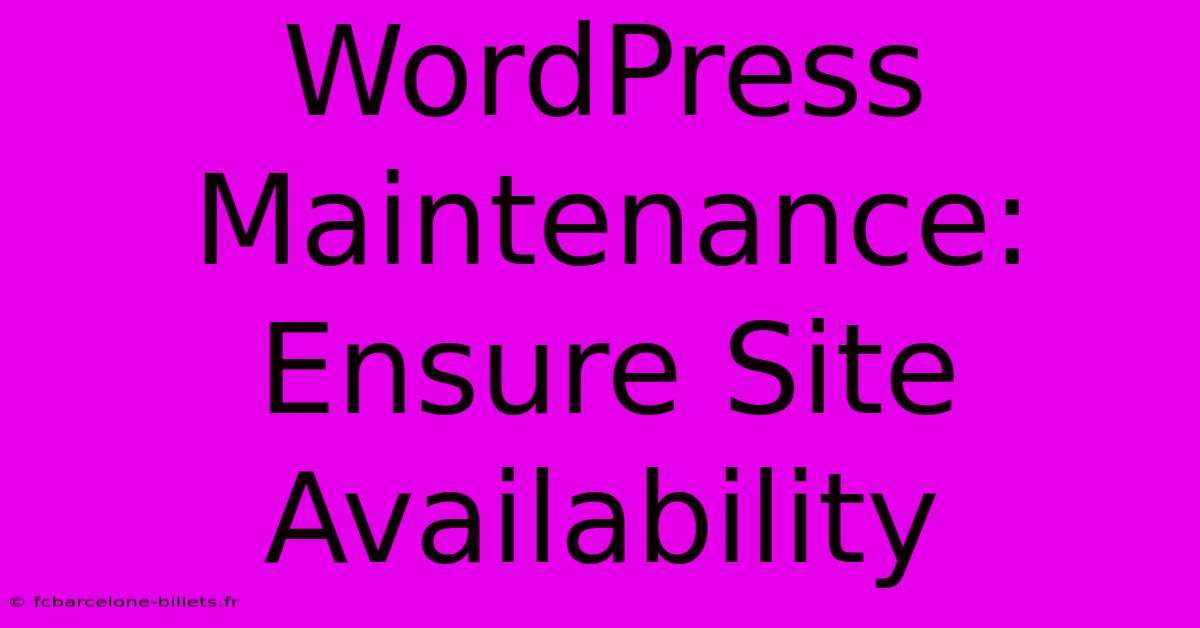WordPress Maintenance: Ensure Site Availability

Table of Contents
WordPress Maintenance: Ensure Site Availability
Maintaining a WordPress website is crucial for ensuring its availability, performance, and security. Neglecting regular maintenance can lead to downtime, security vulnerabilities, and a poor user experience, ultimately harming your online presence and business. This comprehensive guide outlines essential WordPress maintenance tasks to keep your site running smoothly.
Understanding the Importance of WordPress Maintenance
A well-maintained WordPress website is a reliable website. Regular maintenance prevents problems before they escalate, saving you time, money, and potential reputational damage. Key benefits include:
- Improved Performance: Faster loading speeds lead to better user experience and higher search engine rankings.
- Enhanced Security: Regular updates and security checks minimize vulnerabilities and protect your site from attacks.
- Increased Uptime: Preventative maintenance reduces the risk of unexpected downtime, keeping your site accessible to visitors.
- Better SEO: A fast, secure, and well-maintained site is a key factor in improving your search engine optimization (SEO).
- Data Backup Protection: Regular backups safeguard your valuable content and data against loss or corruption.
Essential WordPress Maintenance Tasks
Here's a breakdown of critical maintenance tasks you should perform regularly:
1. Regularly Update WordPress Core, Themes, and Plugins
This is arguably the most important maintenance task. Outdated software is vulnerable to security exploits and can cause compatibility issues. Always update to the latest versions of:
- WordPress Core: This is the foundation of your website. Updates often include critical security patches and performance improvements.
- Themes: Outdated themes can lead to design glitches, security vulnerabilities, and compatibility problems with plugins.
- Plugins: Plugins add functionality to your site, but outdated plugins are major security risks. Ensure all plugins are up-to-date and only use plugins from reputable sources.
2. Perform Regular Backups
Backups are your safety net. They allow you to restore your website in case of data loss due to hacking, accidental deletion, or server issues. Consider using a plugin like UpdraftPlus or BackupBuddy for automated backups. Aim for daily or weekly backups, depending on how frequently your site is updated.
3. Monitor Website Performance
Regularly check your website's speed and performance. Use tools like Google PageSpeed Insights or Pingdom Website Speed Test to identify areas for improvement. Slow loading times can negatively impact user experience and SEO. Consider optimizing images, using a caching plugin, and choosing a reliable hosting provider.
4. Optimize Database
Over time, your WordPress database can become bloated with unnecessary data. This can negatively impact performance. Use a plugin like WP-Optimize to clean up the database, removing revisions, trashed posts, and other unnecessary data.
5. Security Checks and Maintenance
Security is paramount. Take these steps to protect your site:
- Strong Passwords: Use strong, unique passwords for your WordPress admin account and other user accounts.
- Regular Security Scans: Utilize security plugins like Wordfence or Sucuri to scan your site for malware and vulnerabilities.
- Firewall: Implement a firewall to block malicious traffic.
- Two-Factor Authentication: Enable two-factor authentication for added security.
6. Check for Broken Links
Broken links offer a poor user experience and can negatively impact SEO. Regularly check for broken links using plugins or online tools. Fix or remove broken links to maintain a clean website.
Choosing the Right Hosting Provider
Your hosting provider plays a significant role in your website's availability and performance. Select a reliable hosting provider that offers:
- Uptime Guarantees: Look for providers with high uptime guarantees (99.9% or higher).
- Fast Servers: Fast server speeds are essential for quick loading times.
- Regular Backups: Some hosting providers offer automated backups as part of their services.
- Security Features: Choose a provider that offers security features like firewalls and malware scanning.
Conclusion
Regular WordPress maintenance is not optional; it’s essential for the long-term health and success of your website. By implementing the tasks outlined above, you can significantly improve your website’s performance, security, and availability, ensuring a positive user experience and contributing to your overall online success. Remember, proactive maintenance is far more effective and cost-efficient than reactive troubleshooting.

Thank you for visiting our website wich cover about WordPress Maintenance: Ensure Site Availability. We hope the information provided has been useful to you. Feel free to contact us if you have any questions or need further assistance. See you next time and dont miss to bookmark.
Featured Posts
-
Cepa Barcelona Experience The Sun Sea And Wine
Apr 04, 2025
-
Your Perfect Companion The Barcelona Red 4 Runner
Apr 04, 2025
-
Barcelona Cab Fare Can I Pay With My Card
Apr 04, 2025
-
Hostal Absolut Stay Close To All The Action
Apr 04, 2025
-
Key Injuries And Lineups Unionistas Vs Barcelona Atletic
Apr 04, 2025
